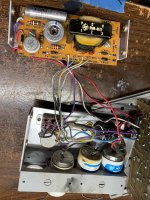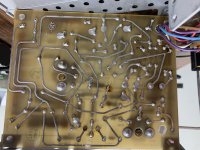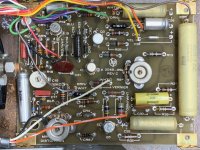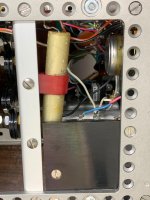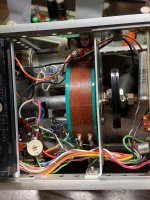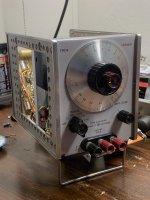I picked up a pair of old oscillators AS-IS for $60. A General Radio 1309A and an HP 204B. Turns out, neither of them work, as in nothing I do with the controls modifies the signal I get on my scope.
The GR model looks clean inside. Nothing obviously broken, fuse doesn't blow, and the power light even comes on.
The HP has four exploded ni-cad batteries, as well as evidence of previous repair (I see "fresh" solder spots, and someone labeled the polarity of the batteries on the inside of the chassis).
I'm posting wondering if there are any general approaches to repairing an oscillator - common failure modes, etc. Or simply to see if anyone has any suggestions about where I should begin.
EDIT: Pictures in comment #9
The GR model looks clean inside. Nothing obviously broken, fuse doesn't blow, and the power light even comes on.
The HP has four exploded ni-cad batteries, as well as evidence of previous repair (I see "fresh" solder spots, and someone labeled the polarity of the batteries on the inside of the chassis).
I'm posting wondering if there are any general approaches to repairing an oscillator - common failure modes, etc. Or simply to see if anyone has any suggestions about where I should begin.
EDIT: Pictures in comment #9
Last edited:
Start by getting the schematics and posting them here.
A couple pictures, both panel and guts wouldn´t hurt.
And what "signal" are you talking about?
ARE they oscillating or it´s just 60Hz hum?
A couple pictures, both panel and guts wouldn´t hurt.
And what "signal" are you talking about?
ARE they oscillating or it´s just 60Hz hum?
I just hate it! All my amplifiers oscillate, and the damn oscillators just lay there, not moving. Shoot!
I'm just getting a hum. I could have phrased that more clearly.
I think Enzo has found the schematics, at least for the HP. I'll get some pictures up in a little bit.
I think Enzo has found the schematics, at least for the HP. I'll get some pictures up in a little bit.
Start with the power supply. Old and neglected nicads will either be leaking or shorted or maybe both. Some power supplies use the nicads as shunt regulators, so you can't just remove the battery and expect the unit to work properly.
Any big power resistors should be checked; that was the problem with an HP 200CD and a 1955 Chevrolet AM radio that I fixed.
Any big power resistors should be checked; that was the problem with an HP 200CD and a 1955 Chevrolet AM radio that I fixed.
How should I approach replacing batteries? Can I stick a bunch of AA’s of the right voltage in? (I saw someone did this on another forum) Do I need to account for the recharging circuit?
The HP probably uses the batteries as part of the regulation. You can use a stack of AA nicad cells as the cheapest way to get it running again. The documentation for it should be pretty good. http://hparchive.com/Manuals/HP-204B-Manual-sn-416.pdf The battery requirement would be 20 1.2V cells.
The GR is really interesting in how many different ways they set up to use the tuned circuit. https://www.ietlabs.com/pdf/Manuals/GR/1309-A Oscillator.pdf
The GR is really interesting in how many different ways they set up to use the tuned circuit. https://www.ietlabs.com/pdf/Manuals/GR/1309-A Oscillator.pdf
Here are some pictures. They are, in order:
* Batteries/power supply board
* Back of main board
* Front of main board
* Side of knob connections
* Bottom of knob connections
* Money shot
I noticed what looks like charring on the back of the battery housing (would be ~half way up when installed), as well as splices on some of the wires. I also see evidence of repairs on the main board. Otherwise, there are no obvious sings of damage.
-
Do I need to use rechargeable batteries if I stick in a slab of AA's?
* Batteries/power supply board
* Back of main board
* Front of main board
* Side of knob connections
* Bottom of knob connections
* Money shot
I noticed what looks like charring on the back of the battery housing (would be ~half way up when installed), as well as splices on some of the wires. I also see evidence of repairs on the main board. Otherwise, there are no obvious sings of damage.
-
Do I need to use rechargeable batteries if I stick in a slab of AA's?
Attachments
YES.Do I need to use rechargeable batteries if I stick in a slab of AA's?
Just browsed the schematic, and as mentioned earlier, the shown power supply is a constant current charger and NiCad batteries are used as a crude voltage regulator.
You´ll have "whatever they charge to" so even the +/-13V indicated are not guaranteed by any means.
Do you have the original charger circuit?
Best bet would be either:
1) make a simple +/-13V supply, I bet regulated +/-12V will be close enough, after all batteries will soon lose some of full charge voltage with use and oscillator "should" still be able to work.
Later will look at circuit and manual in more detail.
2) Do NOT connect a bunch of regular AAs, charger will overcharge and burst them, it´s a very crude one, no voltage limits, etc.
Hey! ... 60´s Technology!
3) Or you might, strictly for testing and repair, do NOT connect the charger circuit AT ALL, but given the price of Alkaline batteries, buying 20 of them will be more than building a proper +/-12V supply, which only requires 12+12V transformer - bridge - 2 x 2200 or 4700 uF x 25V caps, 7812+7912 - couple small heatsinks - couple ceramics plus spare change.
You might even use the original non centertapped PT and ground the center artificial ground, if positive and negative rail consumption is roughly the same. (don´t see why not).
You could just use some high power 12V Zeners to replace the batteries as a test- https://www.mouser.com/ProductDetai...CZ5350B-TR-PBFREE?qs=l7cgNqFNU1izFJvJQceePQ== You definitely want the Nicads for batteries. That thing uses so little power it could probably run for days on AA NiCad batteries Here is 20 for $16. https://www.amazon.com/GEILIENERGY-...9Y2xpY2tSZWRpcmVjdCZkb05vdExvZ0NsaWNrPXRydWU= You would need two 10 cell clips and then figure out how to fit them in the box.
The GR oscillator uses a thermistor for stabilization. Hopefully its still good. Those are more of an effort to find.
The GR oscillator uses a thermistor for stabilization. Hopefully its still good. Those are more of an effort to find.
- Home
- Design & Build
- Equipment & Tools
- How to approach dead oscillators
